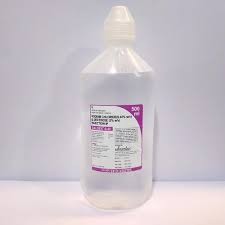
DEXTROSE/ VIOSER 5% Price
Active Substance: Dextrose monohydrate.
Overview
Welcome to Dwaey, specifically on DEXTROSE/ VIOSER 5% page.
This medicine contains an important and useful components, as it consists of
Dextrose monohydrateis available in the market in concentration
Name
Dextrose monohydrate
Precaution
<p>Dextrose monohydrate should be administered with caution in patients with diabetes mellitus, renal impairment, or any condition that predisposes to hyperglycemia or fluid overload, such as congestive heart failure or pulmonary edema. Frequent monitoring of blood glucose levels, serum electrolytes, and fluid balance is essential. In patients receiving parenteral nutrition, thiamine supplementation may be necessary to prevent Wernicke's encephalopathy. Use with care in unconscious patients or those with head trauma, as excessive glucose may exacerbate cerebral edema.</p>
Indication
<p>Dextrose monohydrate is indicated for the treatment of hypoglycemia, as a source of carbohydrate calories in parenteral nutrition, and to provide fluid and energy in various clinical settings, including perioperative care, shock, dehydration, or starvation. It is also used as a diluent for other medications and as part of intravenous fluid replacement therapy in cases requiring glucose supplementation.</p>
Contra indication
<p>Dextrose monohydrate is contraindicated in patients with known hypersensitivity to dextrose or corn products, clinically significant hyperglycemia, intracranial or intraspinal hemorrhage, and those with severe dehydration in the absence of electrolyte replacement. It should not be used in patients with glucose-galactose malabsorption syndrome or in those with anuria without appropriate electrolyte management.</p>
Side Effect
<p>Common side effects include hyperglycemia, fluid overload, and electrolyte imbalances such as hyponatremia or hypokalemia. Less common but serious reactions include thrombophlebitis at the infusion site, infection, and allergic reactions such as rash or urticaria. Prolonged or excessive administration may result in lactic acidosis or hepatic steatosis in parenterally fed patients.</p>
Pregnancy Category ID
Information not available
Mode of Action
<p>Dextrose monohydrate provides readily available glucose, which is metabolized to carbon dioxide and water, releasing energy in the form of ATP. It serves as a primary source of energy for cellular metabolism and is especially critical in conditions of glucose depletion. When infused intravenously, it restores plasma glucose concentrations and supports basal metabolic functions in tissues, particularly the brain.</p>
Interaction
<p>Dextrose solutions may interact with medications that affect glucose metabolism, such as insulin, oral hypoglycemics, and corticosteroids. It may precipitate electrolyte imbalances when used concurrently with diuretics, corticosteroids, or other agents influencing sodium and potassium levels. Co-administration with calcium-containing solutions may result in precipitation; compatibility must be verified before mixing with other intravenous medications.</p>
Pregnancy Category Note
<p>Dextrose monohydrate is generally considered safe during pregnancy (typically Category A or B depending on the region). It is commonly used to treat maternal hypoglycemia or to support fluid and caloric needs during labor. However, careful monitoring is advised, as excessive glucose may lead to fetal hyperglycemia and reactive neonatal hypoglycemia.</p>
Adult Dose
<p>The dose varies based on clinical need. For hypoglycemia, 25–50 mL of 50% dextrose solution may be administered IV. For maintenance or fluid supplementation, 500–1000 mL of 5% or 10% dextrose solution may be infused over several hours. The rate should not exceed the patient's glucose utilization capacity (typically 4–5 mg/kg/min in adults).</p>
Child Dose
<p>For neonates with hypoglycemia, 2 mL/kg of 10% dextrose solution may be administered IV. Maintenance therapy typically involves 5–10% dextrose solutions infused at 100–150 mL/kg/day depending on age and clinical condition. Infusion rates and concentrations should be adjusted based on serum glucose monitoring and tolerance.</p>
Renal Dose
<p>No specific dosing adjustment is necessary for mild renal impairment. However, in cases of moderate to severe renal dysfunction, fluid and electrolyte status must be closely monitored to avoid volume overload and electrolyte disturbances. Glucose administration should be minimized in patients with advanced renal failure unless medically indicated.</p>
Administration
<p>Dextrose monohydrate is administered intravenously, typically via peripheral or central line depending on the concentration. Hypertonic solutions (>10%) are usually given via central venous access to reduce the risk of vein irritation or thrombophlebitis. Ensure aseptic technique during preparation and administration. The infusion rate should be carefully adjusted based on blood glucose monitoring and clinical condition.</p>
